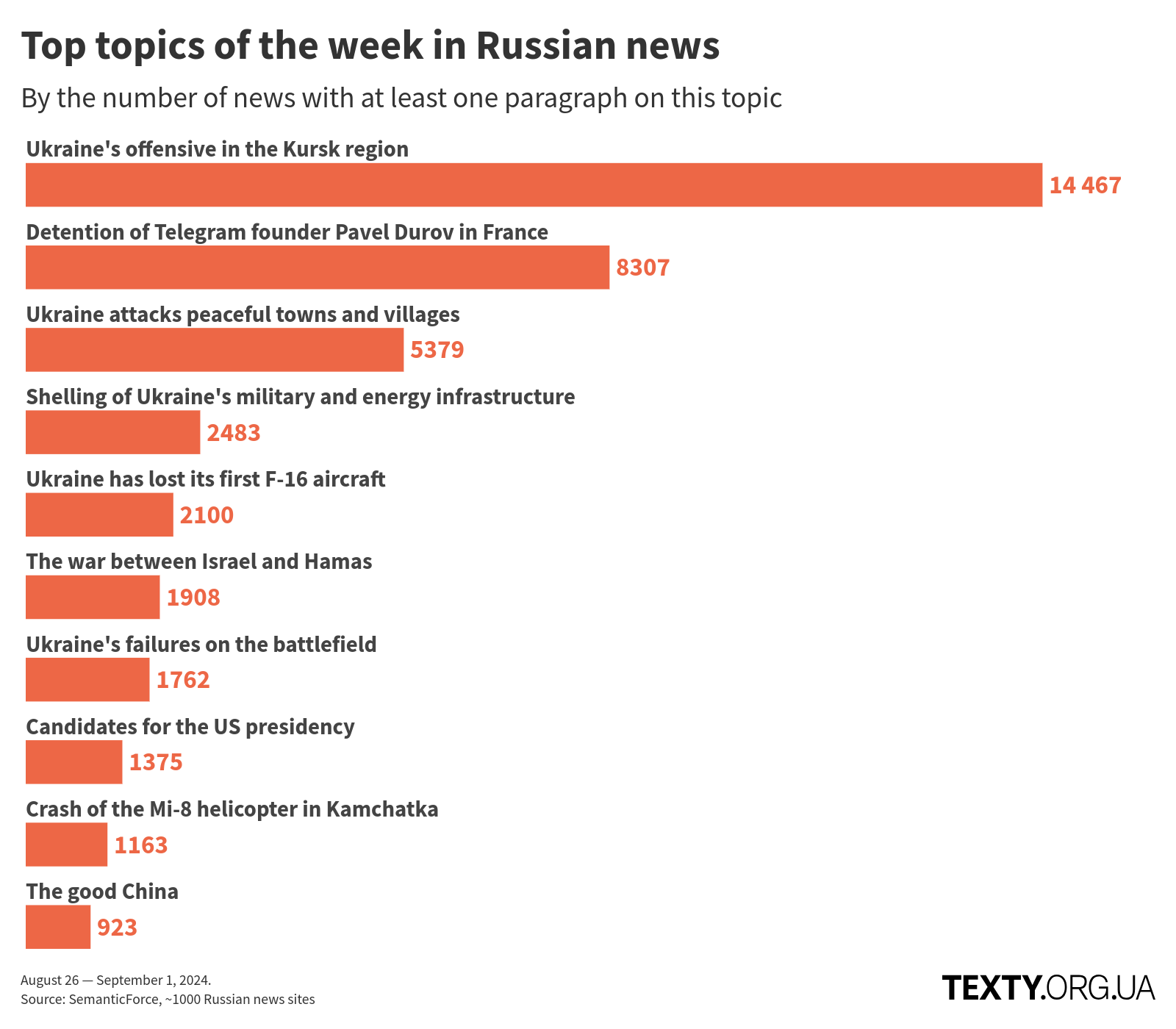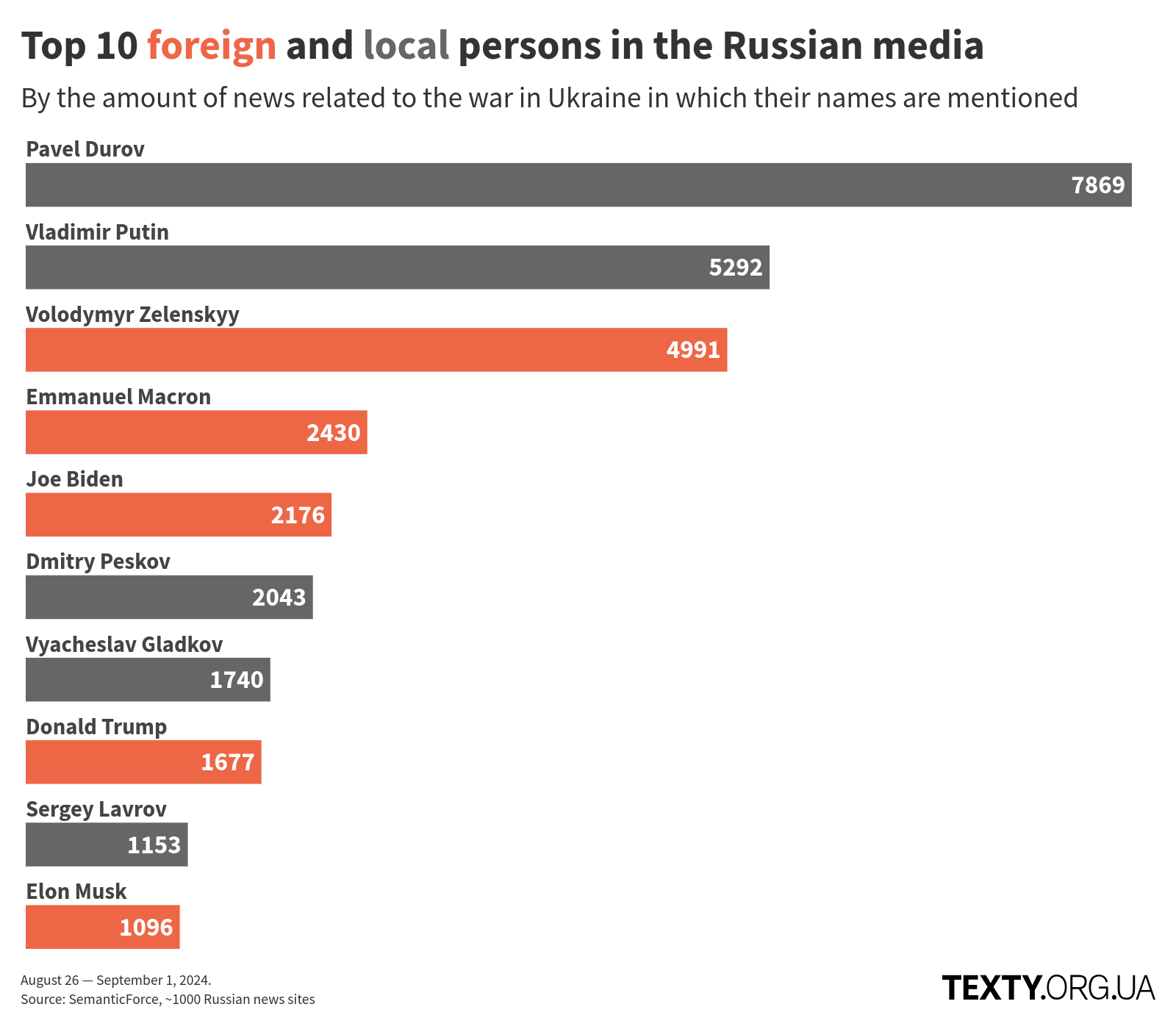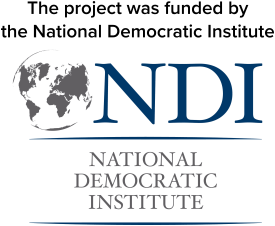Missile propaganda: Ukrainian successes silenced, Russian strikes praised. Russian Media Monitoring Report, August 26-September 1, 2024
In recent weeks, Russian media have been actively covering the shelling of Ukrainian territory while avoiding detailed discussions of Ukraine's aerial counterstrikes on Russian soil. This approach aims to shape a specific information agenda within Russia.
Propaganda has taken on new emphases: abandoning humanity when covering attacks on Ukraine, harsher rhetoric, and a focus on revenge.
Read about this and more in the latest edition of our monitoring of Russian state media and manipulative websites that deliberately spread Russian disinformation.

War of missiles and drones: propaganda ignores Ukraine's successes
In our monitoring of Russian disinformation, we typically focus on what Russian media wrote about last week. But in today's article, we also want to talk about what they didn't write.
Russian media remained silent on numerous successful strikes by the Ukrainian Armed Forces (AFU) on targets in Russia.
Disinformers have trapped themselves: they constantly talk about successes in demilitarizing Ukraine while Ukraine hits energy and military facilities deep within Russian territory. However, you won't find news about such hits in Russian media.
This is done to prevent the population from losing faith in the authorities' ability to protect their way of life and to avoid raising doubts about the Kremlin's victory rhetoric.
Back in May 2023, Ukraine launched its first drone attack on Moscow. This attack came as a surprise to Russians and sparked a strong reaction.
Official figures made threats: "Deputy Chairman of Russia's Security Council Dmitry Medvedev threatened the physical destruction of the Ukrainian president after the incident," "Speaker of the State Duma Vyacheslav Volodin, in turn, proposed recognizing the 'Kyiv Nazi regime as a terrorist organization.'"
Propagandists claimed that the drones were launched from NATO countries, arguing that Ukraine couldn't have carried out such an operation without its patrons from the US or the UK.
Since then, Ukraine's capabilities have significantly expanded. Today, Kyiv is capable of attacking Russian targets across all of European Russia, and sometimes the drones fly even further. This creates new challenges for Kremlin propaganda.
In August of this year, Kyiv carried out a series of strikes on Russian regions. For instance, the Moscow oil refinery was attacked, as well as the Kashira and Konakovo power plants in the Moscow and Tver regions, respectively. In the Rostov region, a Ukrainian Defense Forces strike set a fuel depot ablaze for 16 days.
Official Russian sources try to downplay the significance of these attacks, reporting them without specifics and emphasizing the lack of casualties or serious damage.
News about Ukrainian shelling of Russian regions typically includes phrases like: "N enemy birds shot down approaching...," "N drones were shot down over...," "no one was injured as a result of the debris falling," "according to preliminary information, there were no damages or casualties at the debris site."
This is done to assure the average Russian that Russia is not suffering defeats and that the authorities guarantee safety and protection.
The exception is the frontline regions near the Ukrainian border, mainly the Belgorod and Kursk regions.
Belgorod on the sidelines
Russian media cannot ignore the shelling of Crimea and the frontline regions of Russia, such as Belgorod, Kursk, and Bryansk. The news regularly appears in our monitoring under the category "Ukraine attacks peaceful cities and villages." This helps maintain the narrative of aggressive, "terrorist" behavior from Kyiv while information about hits on military targets is deliberately suppressed.
Shelling by Ukrainians of the border regions has become part of the Russian information space, but with each new incident, their coverage becomes increasingly formalized: "The Ukrainian Armed Forces have once again attacked Shebekinsky urban district in Belgorod region."
It feels like the line of information behavior set by the "propaganda guru" Vladimir Solovyov is dominating. In March 2024, he called the residents of Belgorod who complained about the shelling of their city "creatures": "A large number of different creatures pretending to be bloggers have appeared, saying things like, 'The federal government has forgotten Belgorod, help the people! They have nothing, it's horrible, and people feel abandoned; how can you let this happen? While Moscow celebrates, Belgorod perishes.' All this disgusting hysteria is immediately picked up by Ukrainian Nazi media."
In other words, the Kremlin knows about the shelling, sympathizes, calls on people to stay strong, and urges them to wait for victory.
Russian strikes on Ukraine: A new rhetoric
We have observed that in recent weeks, Russian media have been increasingly writing about the destruction of Ukraine's economy and military capabilities by Russian missiles and drones.
Similar reports existed before, but they were not as widespread. Every missile or drone attack is now accompanied by statements about the successful destruction of Ukrainian personnel or military infrastructure. The main newsmaker is Russia's Ministry of Defense, which reports that all targets were achieved as a result of the attacks.
Now, this messaging is produced by all official propaganda channels without waiting for statements from the Russian Ministry of Defense: "The attack carried out by the Russian army on August 26, 2024, in Ukraine was recognized as the most powerful during this entire time."
A new trend in Russian media is the emergence of "snuff effect" elements in the reporting of attacks on Ukraine. Snuff refers to short films or videos that show real deaths, murders, or suicides without the use of special effects. Propaganda employs a kind of text-based snuff by describing in detail the consequences of Russian attacks: "The arriving doctors were young girls with long nails, who screamed, trembled, and didn't know what to do, confused. They were simply loading the heavy, limbless, convulsing, dying people into the cars, and they were losing it."
Previously, reports of Russian strikes were always accompanied by the disclaimer that the Russian army doesn't target civilians or ordinary Ukrainians. However, recent monitoring of disinformation shows that this rule is no longer being followed: "Russian forces are conducting massive missile strikes on Ukrainian cities. Explosions were heard in Kyiv, Dnipro, Odesa, Kryvyi Rih, Kharkiv, Lutsk, and other cities. In several cities, including the Ukrainian capital, water supply was halted." The focus has shifted to mass destruction and the devastation of infrastructure.
The catalyst for this was the Kursk operation.
The Ukrainian Armed Forces' advance in the Kursk region is causing resonance in Russian society. Radicals are calling for Ukraine to be punished. Russia's massive missile attacks on Ukrainian cities are a response to the demand for an "abnormally powerful strike."
This is why news of explosions in Ukrainian cities has increased: "Explosions occurred in Lviv in western Ukraine," "Explosions occurred in Kyiv and Poltava regions," "Explosions were heard during the day in Kyiv," "Explosions were heard in Kharkiv region in eastern Ukraine."
Propaganda particularly enjoys news of explosions in the capital. Russian media not only reports on the damage but also on the air raids: there is an air raid alert in Kyiv, and TASS reports on this.
Last week, Russian media, savoring the details, fully quoted reports from the Kyiv City Military Administration about the Russian attack: "In Kyiv, air raids were announced four times during the night, lasting a total of more than five hours. Initially, they were linked to a drone attack, which came in waves from different directions..."
It should be noted that quoting the enemy is a common practice in propaganda. Such quoting emphasizes how much Russians enjoy reading about their attacks. And this is no reason for our authorities to stop issuing such reports.
Propagandists "project" disaster scenarios for Kyiv's residents. For example, they relish news about Russia successfully hitting the Kyiv Hydroelectric Power Station: "There is information that serious damage has been inflicted on the Kyiv Hydroelectric Power Station. The dam has been seriously damaged, traffic on it is prohibited, and the machine hall has been damaged."
The new propaganda rhetoric somewhat contradicts the "correct" narratives. Previously, Russian media regularly reported strikes only with precision weapons and only on military targets. Attempts to freeze Ukrainians by depriving the country of energy were justified by the liquidation of military infrastructure, claiming that Russia was liberating Ukraine from Nazis and not fighting the brotherly people.
But when Ukraine achieves significant success, the Russians take off their mask and write about what truly delights the public and boosts trust in the authorities — the power of Russian weapons that annihilate peaceful Ukrainians.
The same coverage occurred during the missile strikes on Ukraine in October 2022, when Ukraine blew up the Crimean bridge, which could have been perceived in Russia as a blow to Putin's prestige in the eyes of Russians (more on that surge of schadenfreude and hatred in our article "Enjoyment from Terror" from October 18, 2022). Thus, we see a pattern: The Kremlin tries to compensate for battlefield defeats in the eyes of Russians by inflicting greater suffering on ordinary Ukrainians.
Attention to Ukraine's energy system
Another important change is the coverage of strikes on Ukraine's energy infrastructure. Russian propaganda has stopped masking these actions as "the destruction of military targets." Now, strikes on transformers and power lines are presented as necessary actions to destroy Ukraine's economy and civilian infrastructure, which is placed on the same level as military objectives.
News that Ukraine will be left without electricity in winter is presented as a fait accompli: "Ukraine has lost 50 to 90% of its power grids." By the way, presenting future events as facts is another typical technique of Russian disinformation.
Moreover, reports that electricity is being turned off somewhere in Ukraine are presented as important news: "In addition to the Ukrainian capital, electricity is being cut off in the Kyiv and Odesa regions, as well as in the Ukrainian-controlled areas of the Donetsk People's Republic."
In the eyes of the propagandists, hunting for transformers is just as important as the destruction of personnel. Such strikes justify the use of precious missiles.

What else they wrote about
Ukraine lost its first F-16 fighter jet
The loss of the F-16 fighter by Ukraine became one of the key topics in Russian media and sparked a wave of emotions and even euphoria. Propagandists promote the version that the destruction of the aircraft is the result of Russian military actions: "The Russian army may have shot down the F-16 in the Khmelnytskyi region," "The day before, the Russian army launched a missile strike on the airport, after which the fighters were scrambled. They circled the area for two to three hours. As soon as they returned to Starokostiantyniv, the Russian military immediately launched another strike, which could have downed the F-16."
Additionally, disinformers actively used the statement of Ukrainian MP Maryana Bezuhla, who said that the F-16 was shot down by Ukraine's Patriot air defense system due to a lack of coordination between units: "Ukrainian parliament deputy Maryana Bezuhla, citing her own data, reported that the F-16 supplied to Ukraine was shot down by the Patriot air defense system."
Russian propaganda seized upon these statements to highlight Ukrainian failures and undermine confidence in the delivery of Western equipment, particularly American fighter jets.
Ukraine's offensive in the Kursk region
Russian media continue to actively comment on the situation in the Kursk region. In particular, they claim that the strategic objectives of the Kursk operation were not achieved, and the attack had more propaganda significance for Kyiv than real military benefit. The AFU attempted to demonstrate Russia's vulnerability. Still, it is stated that this plan was based on "Ukrainian fantasy" rather than real facts: "The invasion by the Ukrainian Armed Forces initially had propaganda significance for Kyiv and was undertaken at the expense of real military planning. The enemy needed a 'picture' to shout to the West about Russia's 'vulnerability' and the 'safety of red lines,' but in detail, this 'picture' is a product of Ukrainian fantasy."
Last week, propaganda also focused on emphasizing the risks associated with military activity near the Kursk nuclear power plant.
IAEA Director General Rafael Grossi personally visited the station. "It was emphasized that the nuclear power plant should not be a target of military actions under any circumstances. Grossi noted that during the inspection of the plant, he saw traces of drone attacks on its territory. In the event of external impact, there is a threat of a nuclear incident with a potential release of radiation."
Propaganda uses this aspect to intensify fears and demonstrate the dangers of Ukrainian actions in the mentioned region.
If you are interested in receiving an extended version of our monitoring report, please fill out this brief questionnaire.
The Methodology
To monitor the information published on disinformation websites, we analyzed approximately 500,000 news reports collected from ~ 1,000 Russian websites. The data for the analysis was collected and provided by SemanticForce.
Each paragraph was processed using an algorithm which defines its topic automatically. The resulting topics (i.e. groups with similar content) were short-listed by the topics relating to the war or its consequences for Russia. The number of mentions of a certain topic was then counted for each publication. Our conclusions are based on the respective findings and the quotes from paragraphs referring to each topic.

This article was originally written in Ukrainian. It has been translated into English using AI tools such as DeepL, ChatGPT, and Grammarly. If you encounter an error that requires immediate attention, please inform us via Facebook, Twitter, or Instagram. Your understanding and support are appreciated.

